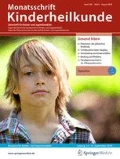Zusammenfassung
Das Neuroblastom ist der häufigste extrakraniale solide Tumor des Kindesalters. Je nach seiner Lokalisation kommt es zu den für Neuroblastome charakteristischen, aber lageabhängigen Symptomen. Ein 123I-MIBG-Scan ist das Standarddiagnoseverfahren der Wahl für alle Tumorlokalisationen. Ebenso sind beidseitig gewonnene Markaspirate der hinteren Darmbeinschaufelleiste und Biopsien des Knochenmarkkerns unverzichtbar. Entscheidender Marker für die Beurteilung der Dignität von neuroblastischen Tumoren ist die MYCN-Onkogen-Amplifikation. Das Neuroblastom muss risikoadaptiert behandelt werden. Aus diesem Grund sind eine entsprechend exakte Diagnostik und Klassifikation unverzichtbar, und die Therapie soll an dafür spezialisierten Zentren und im Rahmen von qualitätssichernden Therapieoptimierungsstudien durchgeführt werden.
Abstract
Neuroblastoma is the most common form of extracranial solid tumor in childhood. Depending on the localization neuroblastomas result in characteristic but site-dependent symptoms. An iodine-123-meta-iodobenzylguanidine (MIBG) scan is the standard diagnostic procedure of choice for all tumor localizations. Bilateral marrow aspirates from the posterior iliac crest and biopsies of bone marrow are also indispensible. The decisive marker for assessment of dignity of neuroblastomas is MYCN oncogene amplification. Neuroblastomas must be treated in a risk-adapted manner. For this reason exact diagnostics and classification are indispensible and the therapy should be carried out in specialized centers within the framework of quality assured therapy optimization studies.





Literatur
Ambros IM, Zellner A, Roald B et al (1996) Role of ploidy, chromosome 1p, and Schwann cells in the maturation of neuroblastoma. N Engl J Med 334:1505–1511
Berthold F, Hero B, Kremens B et al (2003) Long-term results and risk profiles of patients in five consecutive trials (1979–1997) with stage 4 neuroblastoma over 1 year of age. Cancer Lett 197(1–2):11–17
Brodeur GM, Pritchard J, Berthold F et al (1993) Revisions of the international criteria for neuroblastoma diagnosis, staging, and response to treatment. J Clin Oncol 11(8):1466–1477
Cohn SL, Pearson AD, London WB et al (2009) The International Neuroblastoma Risk Group (INRG) classification system: an INRG Task Force report. J Clin Oncol 27:289–297
Hero B, Simon T, Spitz R et al (2008) Localized infant neuroblastomas often show spontaneous regression: results of the prospective trials NB95-S and NB97. J Clin Oncol 26(9):1504–1510
Ladenstein R, Berthold F, Ambros I, Ambros P (2006) Neuroblastome. In: Gadner H, Gaedicke G, Niemeyer C, Ritter J (Hrsg) Pädiatrische Hämatologie und Onkologie. Springer, Berlin Heidelberg New York, S 829–846
Ladenstein R, Poetschger U, Luksch R et al (2011) Busulphan-melphalan is the superior myeloablative therapy (MAT) for high risk neuroblastoma: Results from the HR-NBL1/SIOPEN trial. ASCO 2011/Abstract #79897
Matthay KK, Reynolds CP, Seeger RC et al (2009) Long-term results for children with high-risk neuroblastoma treated on a randomized trial of myeloablative therapy followed by 13-cis-retinoic acid: a children’s oncology group study. J Clin Oncol 27:1007–1013
Matthay KK, George RE, Yu AL (2012) Promising therapeutic targets in neuroblastoma. Clin Cancer Res 18(10):2740–2753
Monclair T, Brodeur GM, Ambros PF et al (2009) The International Neuroblastoma Risk Group (INRG) staging system: an INRG Task Force report. J Clin Oncol 27:298–303
Mossé YP, Laudenslager M, Longo L et al (2008) Identification of ALK as a major familial neuroblastoma predisposition gene. Nature 455(7215):930–935
Mossé YP, Wood A, Maris JM (2009) Inhibition of ALK signaling for cancer therapy. Clin Cancer Res 15(18):5609–5614
Shimada H, Ambros IM, Dehner LP et al (1999) The international neuroblastoma pathology classification (INPC) (the Shimada system). Cancer 86:364–372
Simon T, Hero B, Faldum A et al (2011) Long term outcome of high-risk neuroblastoma patients after immunotherapy with antibody ch14.18 or oral metronomic chemotherapy. BMC Cancer.11:21
Yu AL, Gilman AL, Ozkaynak MF, London WB et al (2010) Anti-GD2 antibody with GM-CSF, interleukin-2, and isotretinoin for neuroblastoma. N Engl J Med 363(14):1324–1334
Interessenkonflikt
Die korrespondierende Autorin gibt an, dass kein Interessenkonflikt besteht.
Author information
Authors and Affiliations
Corresponding author
Rights and permissions
About this article
Cite this article
Ladenstein, R. Aktuelle Therapiestrategien beim Neuroblastom. Monatsschr Kinderheilkd 160, 947–957 (2012). https://doi.org/10.1007/s00112-012-2690-9
Published:
Issue Date:
DOI: https://doi.org/10.1007/s00112-012-2690-9
Schlüsselwörter
- Neuroblastom
- Risikoadaptierte Behandlungskonzepte
- Chromosomale Aberrationen
- MYCN-Protein, menschliches
- Genamplifikation

